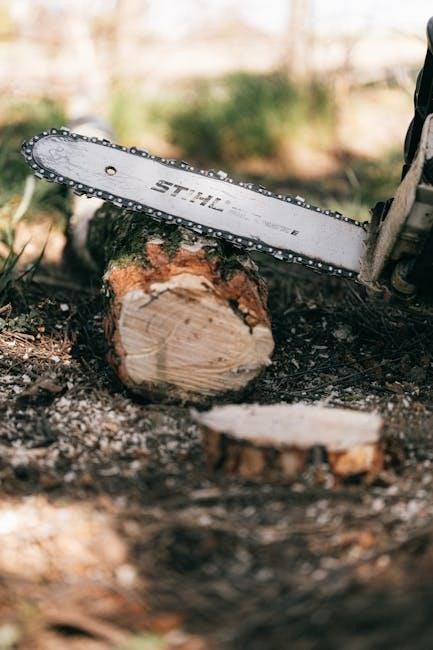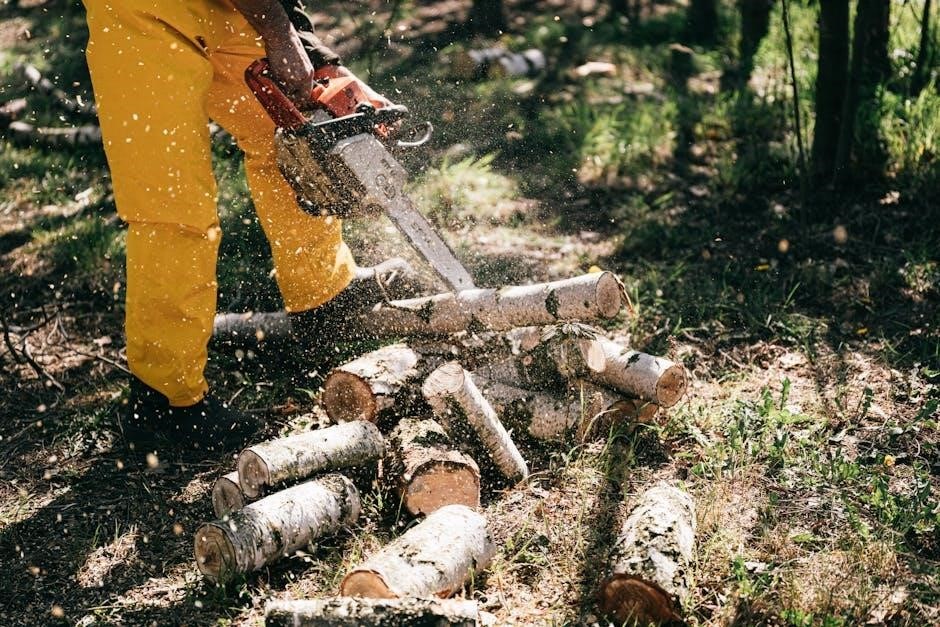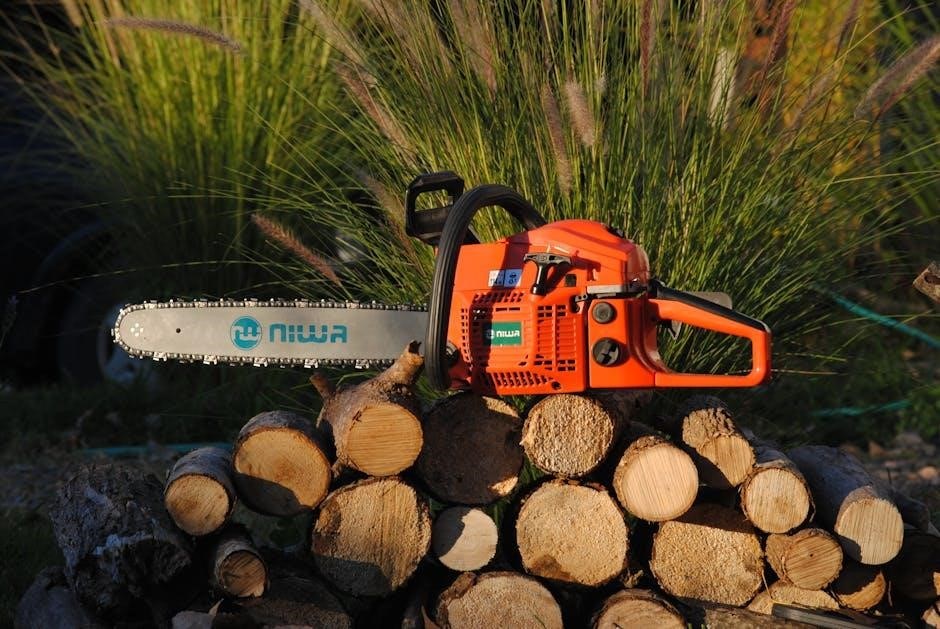
Chainsaw guides provide essential knowledge for safe and effective chainsaw use, covering basics, maintenance, and advanced techniques to enhance productivity and safety for both beginners and experienced users.
1.1 Overview of Chainsaw Basics
A chainsaw is a portable, handheld power tool with a rotating chain along a guide bar, designed for cutting wood. It operates on gasoline or electricity, offering versatility for tasks like tree felling, pruning, and firewood preparation. Understanding its components, such as the chain, bar, and engine, is crucial for effective use. This guide provides foundational knowledge for safe and efficient chainsaw operation.
1.2 Importance of Proper Chainsaw Use
Proper chainsaw use is crucial for safety, efficiency, and environmental sustainability. Improper techniques can lead to accidents, equipment damage, and ineffective cutting. Wearing safety gear, following guidelines, and maintaining the tool ensures optimal performance. Responsible use also minimizes environmental impact, preserving natural resources. Understanding proper chainsaw use is essential for beginners and experienced users to achieve desired results while protecting themselves and the environment.
How Chainsaws Work
Chainsaws operate using a rotating chain with sharp teeth, driven along a guide bar by a motor, typically gasoline or electric. This mechanism allows precise cutting through wood efficiently.
2.1 Components of a Chainsaw
A chainsaw consists of a powerful motor, a guide bar, and a rotating chain with sharp teeth. Additional components include a throttle, air filter, and safety features like a chain brake and protective guard. These parts work together to enable efficient cutting while maintaining user safety and control during operation.
2.2 The Role of the Guide Bar and Chain
The guide bar serves as the track for the chainsaw chain, ensuring precise cutting and stability; The chain, equipped with sharp teeth, rotates along the bar to cut through materials. Together, they enable efficient slicing of wood and other materials. Proper alignment and maintenance of both components are crucial for optimal performance and safety during cutting tasks.

Safety Guidelines for Chainsaw Use
Always wear safety gear, including helmets and gloves, and follow proper cutting techniques. Regularly inspect and maintain the chainsaw to ensure safe and efficient operation.
3.1 Essential Safety Gear
Always wear a helmet with a face shield, safety glasses, gloves, and chainsaw chaps. These protect against flying debris and accidental cuts. Ensure proper fit and compliance with safety standards to minimize risks while operating a chainsaw.
3.2 Precautions to Avoid Accidents
Always maintain a firm stance and grip, ensuring the chainsaw is properly balanced. Keep loose clothing tied back and avoid distractions. Check chain tension and sharpness before use. Be cautious of kickback zones and never cut above shoulder height. Plan escape routes and keep bystanders at a safe distance. Ensure the area is clear of obstacles and flammable materials.

Choosing the Right Chainsaw
Selecting the right chainsaw involves considering power, size, and bar length, ensuring it matches the task and user experience for optimal performance and reliability.
4.1 Factors to Consider When Buying a Chainsaw
When purchasing a chainsaw, consider power source, engine size, bar length, and intended use. Gasoline saws offer more power for heavy tasks, while electric or battery models are ideal for lighter work. Safety features, ergonomics, and maintenance requirements are also crucial. Match the chainsaw size and type to your experience level and specific needs for optimal performance and reliability.
4.2 Chainsaw Size and Bar Length Selection
Chainsaw size and bar length are critical for efficiency and safety. Bar lengths typically range from 16 to 24 inches, with larger bars suited for heavier tasks like felling large trees. Match the bar length to the chainsaw’s power and your specific needs. A longer bar increases cutting capacity but may reduce maneuverability. Always consult the manufacturer’s guide for proper sizing and measurement.
Chainsaw Maintenance Tips
Regular chain sharpening, proper guide bar lubrication, and thorough cleaning ensure optimal performance and longevity. Store chainsaws in a dry place to prevent rust and maintain reliability.
5.1 Sharpening the Chain
Sharpening the chain is crucial for maintaining cutting efficiency. Use a file or grinder to sharpen teeth evenly, following the manufacturer’s angle guidelines. Sharpen after each use to prevent dullness. Hold the file firmly and stroke from inside to out. Check sharpness by cutting a small log. A dull chain increases effort and safety risks, so regular sharpening is essential for optimal performance and safety.
5.2 Lubricating the Guide Bar
Lubricating the guide bar is essential to ensure smooth chain operation and prevent overheating. Use high-quality bar oil, applying it regularly during use. Check oil levels before starting and refill as needed. Proper lubrication reduces friction, extends bar life, and maintains cutting efficiency. Neglecting this step can lead to premature wear and potential damage to the chainsaw. Always follow the manufacturer’s oil recommendations for optimal performance.

Techniques for Effective Cutting
Mastering proper stance, grip, and cutting strategies ensures precision and control. Adapt techniques for different tasks, materials, and angles to achieve safe, efficient, and accurate results consistently.
6.1 Proper Stance and Grip
A balanced stance with feet shoulder-width apart ensures stability. Hold the chainsaw firmly with both hands—one on the rear handle and the other on the front. This grip provides control and reduces fatigue. Keep your body positioned to maintain balance, avoiding one-handed operation. Proper posture and hand placement are critical for safe, precise cutting and minimizing the risk of accidents during operation.
6.2 Strategies for Different Cutting Tasks
Adapt techniques for tasks like felling, limbing, and bucking. Use controlled, shallow cuts for precision. Maintain chain sharpness for efficiency. Apply proper leverage and body positioning. For horizontal cuts, stabilize the log. Vertical cuts require careful alignment. Always plan cuts to manage log movement. These strategies ensure safety and effectiveness in various cutting scenarios, enhancing overall productivity and reducing wear on the chainsaw.
Troubleshooting Common Issues
Identify issues like dull chains or improper lubrication. Address problems promptly to prevent damage. Regular maintenance ensures optimal performance and extends chainsaw lifespan.
7.1 Diagnosing Chain Problems
Identify chain issues by inspecting for wear, dullness, or damage. Check tension and alignment. Look for signs like uneven cutting or vibration. Use diagnostic tools to assess chain condition and determine if sharpening or replacement is needed. Regular inspection prevents unexpected malfunctions and ensures smooth operation. Addressing chain problems early maintains efficiency and safety during cutting tasks.
7.2 Solving Common Chainsaw Malfunctions
Address common chainsaw issues like poor cutting performance or stalling by checking chain tension, sharpening dull teeth, and ensuring proper lubrication. Clean debris from the guide bar and chain. For persistent problems, inspect the air filter and spark plug. Regular maintenance and timely repairs can resolve most malfunctions, ensuring reliable operation and extending the tool’s lifespan.

Advanced Chainsaw Techniques
Mastering advanced chainsaw techniques enhances precision and efficiency in complex cutting tasks, enabling users to tackle challenging projects with confidence and skill.
8.1 Precision Cutting Methods
Precision cutting methods involve advanced techniques like scoring, plunge cutting, and controlled leverage to achieve accurate results. These methods ensure clean cuts and minimal waste, especially in intricate or large-scale projects. Proper chain tension and angle alignment are crucial for maintaining precision. Regular chain sharpening and bar lubrication also enhance cutting accuracy, making these techniques indispensable for professionals and DIY enthusiasts alike.
8.2 Using Chainsaws for Specialized Tasks
Chainsaws can be adapted for specialized tasks like ice carving, meat cutting, and Alaskan milling. These tasks require specific chain types and techniques. For example, ice carving demands a unique chain with carbide teeth for smooth cuts, while meat cutting needs a sanitary, high-speed setup. Specialized tasks often involve custom bar lengths and safety precautions to ensure precision and safety in unconventional applications.
Environmental Considerations
Chainsaws, when used responsibly, support sustainable forestry and minimize environmental impact. Proper techniques reduce waste and protect ecosystems, promoting eco-friendly practices.
9.1 Sustainable Logging Practices
Sustainable logging involves selective cutting, minimizing waste, and protecting ecosystems. Chainsaws play a key role by enabling precise cuts and reducing environmental impact. Eco-friendly practices like replanting and avoiding sensitive areas ensure forest health. Proper techniques help maintain biodiversity and prevent soil erosion, promoting responsible resource management.
9.2 Minimizing Environmental Impact
Minimizing environmental impact involves using chainsaws responsibly to avoid unnecessary damage. Proper chain maintenance ensures efficient cutting, reducing fuel use and emissions. Avoiding sensitive habitats and minimizing waste wood helps preserve ecosystems. Selective logging and replanting efforts promote sustainable forestry, maintaining biodiversity and forest health for future generations while reducing the ecological footprint of chainsaw use.
Chainsaw Accessories and Enhancements
Chainsaw accessories, such as guide bars and chains, enhance functionality. Upgrades like improved lubrication systems and ergonomic handles boost productivity and efficiency, ensuring optimal performance and durability.
10.1 Useful Accessories for Chainsaw Users
Essential accessories like guide bars, chains, and sharpening tools enhance chainsaw efficiency. Safety gear such as helmets, gloves, and protective eyewear is crucial. Additional items like chain lubricants, scabbards, and thigh guards improve performance and safety. These accessories ensure optimal functionality and protect users from potential hazards, making them indispensable for both professionals and DIY enthusiasts.
10.2 Upgrading Your Chainsaw
Upgrading your chainsaw can enhance performance and longevity. Consider high-quality guide bars and chains for improved cutting efficiency. Chain sharpening kits and advanced lubrication systems are valuable additions. Additionally, upgrading to a more powerful engine or switching to an electric starter can simplify use. Anti-vibration handles and reinforced bars reduce fatigue and risk. These upgrades ensure your chainsaw remains reliable and efficient for demanding tasks.
Chainsaw Guide Bars and Chains
Chainsaw guide bars and chains are critical for optimal performance. Proper fitting and compatibility ensure smooth operation. Measuring correctly and selecting the right chain type guarantees top performance and longevity.
11.1 Measuring and Replacing Guide Bars
Measuring and replacing chainsaw guide bars ensures optimal performance. Always check the manufacturer’s manual for exact measurements. Use a ruler or caliper to measure the bar’s length and width. When replacing, ensure the new bar matches the old one’s specifications. Proper fitting prevents vibration and enhances cutting efficiency. Tighten the chain correctly after installation for smooth operation and safety.
11.2 Selecting the Right Chain Type
Selecting the right chain type is crucial for efficient cutting. Chains vary in pitch, gauge, and tooth style. Full chisel chains are ideal for softwood, while semi-chisel chains work better for hardwood. Ripping chains are designed for straight cuts in large logs. Always match the chain to your saw’s specifications and the task at hand to ensure optimal performance and safety.
Mastering chainsaw use requires practice, safety awareness, and proper maintenance. Always follow guidelines, stay updated on techniques, and continuously improve your skills for optimal performance and safety.
12;1 Best Practices for Chainsaw Use
Always wear safety gear, including a helmet, gloves, and protective clothing. Regularly maintain the chainsaw, sharpen the chain, and lubricate the guide bar. Use proper stance and grip for control. Plan cuts carefully, avoiding overreaching. Keep the chainsaw at a safe distance from bystanders. Store the chainsaw in a dry place when not in use. Stay updated on the latest safety techniques and best practices for optimal performance and safety.
12.2 Continuous Learning and Improvement
Continuous learning is crucial for mastering chainsaw use. Stay updated on new techniques, safety protocols, and tool advancements. Engage in workshops, online tutorials, and hands-on practice to refine skills. Learn from experienced professionals and adapt to diverse cutting scenarios, such as metal or ice. Regularly assess and improve your approach to ensure efficiency, precision, and safety in every task.
Leave a Reply
You must be logged in to post a comment.